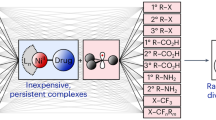Abstract
THERE has been considerable discussion concerning the molecular symmetry of dibenzene chromium, (C6H6)2Cr (refs. 1 and 2). Theoretical considerations led Ruch3 to the assumption of a three-fold symmetry of the benzene ligands in the complex, the rings probably being slightly puckered4. Fritz and Lüttke5 stated that the infra-red absorption spectrum of (C6H6)2Cr was incompatible with six-fold symmetry and proposed molecular symmetry D3d. Recently, however, the same investigators6 changed their interpretation of the spectrum ; they proposed symmetry D6h both for the molecule (C6H6)2Cr and for the cation (C6H6)2Cr+ ; this conclusion was based on a study of the infra-red and Raman spectra, mainly of (C6H6)2CrI. Snyder7 also proposed an assignment of the infra-red spectrum of solid dibenzene chromium based on molecular symmetry D6h. Six-fold symmetry of the benzene ligands is also assumed by most other investigators in the field of arene metal compounds2,8.
This is a preview of subscription content, access via your institution
Access options
Subscribe to this journal
Receive 51 print issues and online access
$199.00 per year
only $3.90 per issue
Buy this article
- Purchase on Springer Link
- Instant access to full article PDF
Prices may be subject to local taxes which are calculated during checkout
Similar content being viewed by others
References
Fischer, E. O., and Fritz, H. P., in “Advances in Inorganic Chemistry and Radiochemistry”, 1, 55 (Academic Press, Inc., New York, 1959).
Wilkinson, G., and Cotton, F. A., in “Progress in Inorganic Chemistry”, 1, 1 (Interscience Publishers, Inc., New York, 1959).
Ruch, E., “Ber. Jahrestagung Chem. Ges. DDR, Leipzig”, 125 (1959).
Fischer, E. O., Internat. Conf. Co-ord. Chem., London, April 1959, 73. Special Publication No. 13, The Chemical Society, London (1959).
Fritz, H. P., and Lüttke, W., Internat. Conf. Co-ord. Chem., London, April, 123. Special publication No. 13, The Chemical Society, London (1959). See also ref. 1, p. 105.
Fritz, H. P., Lüttke, W., Stammreich, H., and Forneris, R., Chem. Ber., 92, 3246 (1959).
Snyder, R. G., Spectrochim. Acta, 15, 807 (1959).
Dyatkina, M. E., and Shustorovich, E. M., Russian J. Inorg. Chem., 4, 179 (1959).
Weiss, E., and Fischer, E. O., Z. allg. anorg. Chem., 286, 142 (1956).
Dunitz, J. D., Orgel, L. E., and Rich, A., Acta Cryst., 9, 373 (1956).
Carradini, P., and Allegra, G., J. Amer. Chem. Soc., 81, 2271 (1959); 82, 2075 (1960).
Jellinek, F., Acta Cryst., 11, 677 (1958).
Mulay, L. N., Rochow, E. G., and Fischer, E. O., J. Inorg. Nucl. Chem., 4, 231 (1957).
Cox, E. G., Cruickshank, D. W. J., and Smith, J. A. S., Nature, 175, 766 (1955).
Langseth, A., and Stoicheff, B. P., Canad. J. Phys., 34, 350 (1956).
Brown, R. G., Trans. Farad. Soc., 55 694 (1959). Costain, C. C., and Stoicheff, B. P., J. Chem. Phys., 30, 777 (1959). Somayajulu, G. R., ibid., 31, 919 (1959).
For literature, see ref. 2, p. 77.
Author information
Authors and Affiliations
Rights and permissions
About this article
Cite this article
JELLINEK, F. Character of the Ligands in Dibenzene Chromium. Nature 187, 871–872 (1960). https://doi.org/10.1038/187871a0
Issue Date:
DOI: https://doi.org/10.1038/187871a0
This article is cited by
-
Zur metall-ring-bindung in sandwich-komplexen
Theoretica Chimica Acta (1963)
-
Crystal structure of ditoluenechromium iodide
Journal of Structural Chemistry (1961)
-
Zur Kristallstruktur von Di-benzol-molybd�n (0) und Di-benzol-wolfram (0)
Die Naturwissenschaften (1961)
Comments
By submitting a comment you agree to abide by our Terms and Community Guidelines. If you find something abusive or that does not comply with our terms or guidelines please flag it as inappropriate.



